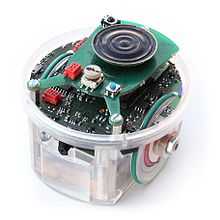E-puck mobile robot

The e-puck is a small (7 cm) differential wheeled mobile robot. It was originally designed for micro-engineering education by Michael Bonani and Francesco Mondada at the ASL laboratory of Prof. Roland Siegwart at EPFL (Lausanne, Switzerland). The e-puck is open hardware and its onboard software is open source, and is built[1] and sold[2] by several companies.
Technical details
- Diameter: 70 mm
- Height: 50 mm
- Weight: 200 g
- Max speed: 13 cm/s
- Autonomy: 2 hours moving
- dsPIC 30 CPU @ 30 MHz (15 MIPS)
- 8 KB RAM
- 144 KB Flash
- 2 step motors
- 8 infrared proximity and light (TCRT1000)
- color camera, 640x480
- 8 LEDs in ring + one body LED + one front LED
- 3D accelerometers
- 3 microphones
- 1 loudspeaker
Extensions
New modules can be stacked on top of the e-puck; the following extensions are available:[3]
- a turret that simulates 1D omni-directional vision, to study optic flow,
- ground sensors, for instance to follow a line,
- color LED turret, for color-based communication,
- ZigBee communication,
- 2D Omni-directional vision,
- magnetic wheels, for vertical climbing.
Scientific use
Since the e-puck is open hardware, its price is lower than competitors.[4] This is leading to a rapid adoption by the scientific community in research[5] despite the original educational orientation of the robot. The e-puck has been used in collective robotics , evolutionary robotics , and art-oriented robotics .
References
- ↑ GCtronic and AAI
- ↑ Cyberbotics, RoadNarrows Robotics, and K-Team
- ↑ see extensions section at e-puck.org
- ↑ the e-puck costs around 950 CHF at time of writing, while the Khepera is around 3000 CHF
- ↑ A search on Google scholar of e-puck + mobile + robot returns 528 papers (2012-01-05)
External links
- Homepage - the e-puck project homepage
- e-puck at Mobots - the e-puck homepage at Mobots, the group who developed the e-puck
- e-puck at gna - the gna page of e-puck onboard software
- Cyberbotics' robot curriculum - a robotics curriculum based on the e-puck robot